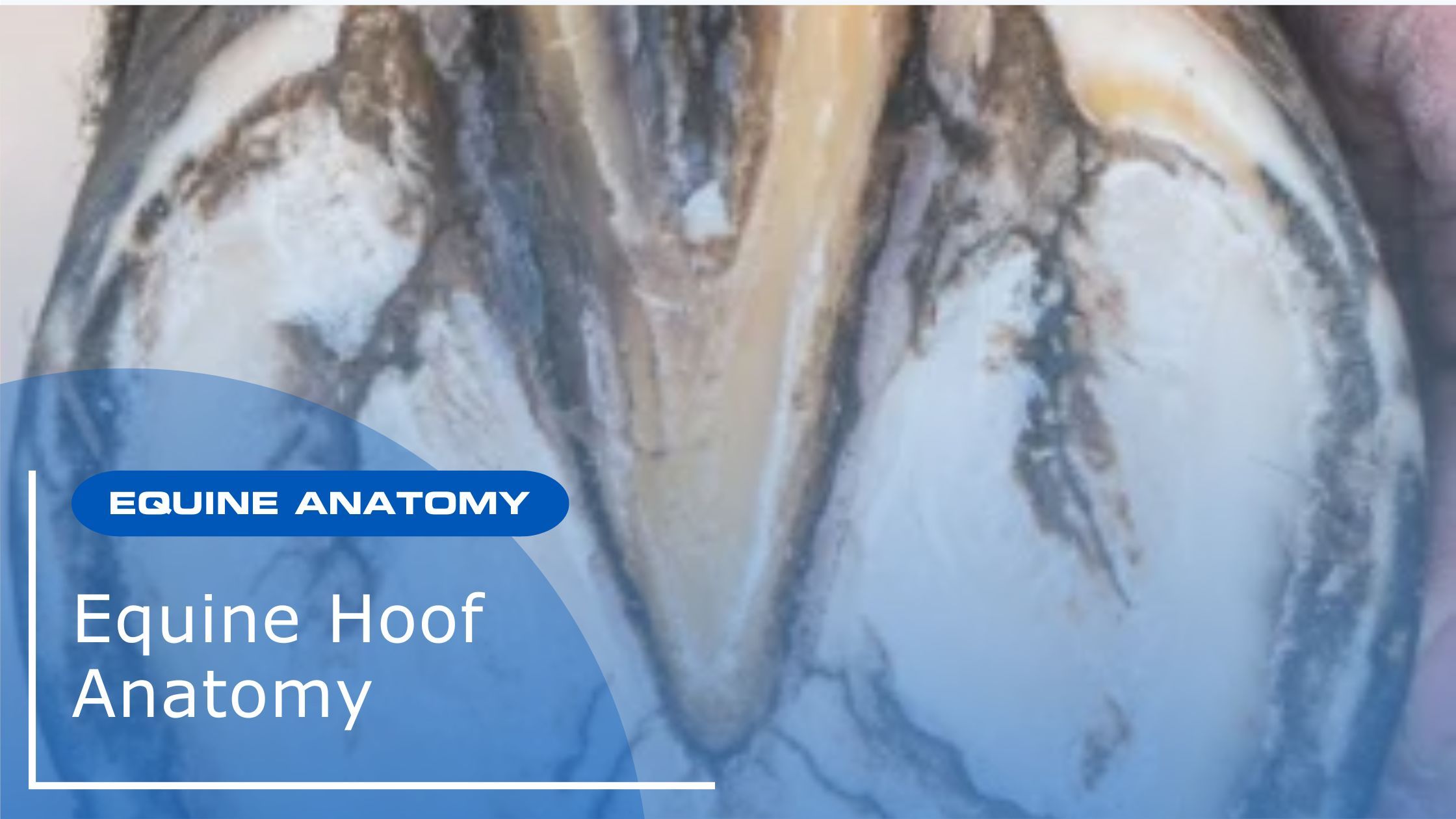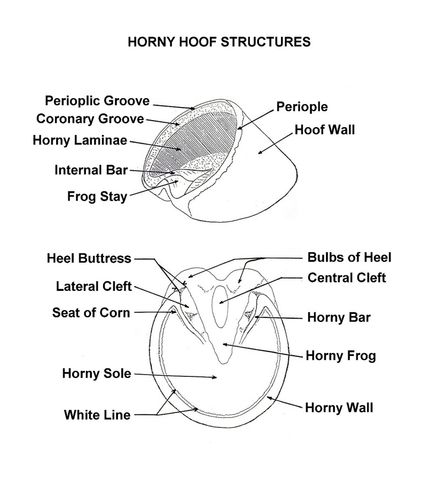Equine Hoof Anatomy
Today we’ll be diving into equine hoof anatomy. In this article expert farrier Dean Lewis will be providing an explanation of the hoof anatomy of a horse, as well as looking at some factors which can impact hoof growth and health:
We all know the old saying “no hoof, no horse!”
But how much do most of us know about the hoof and how it functions?
Throughout my career as a professional farrier, many people have expressed interest in equine hoof anatomy and the function of the horse’s hoof, with some saying that equine hoof anatomy is either a great design, or the worst design ever.
The horse is an amazing animal that has been around for millions of years. Throughout the centuries man has utilised the horse for both war and work as well as more pleasurable pursuits.
Additionally, the horse is one of the fastest animals on the planet for its size, and can perform majestic athletic manoeuvres, in all types of regions and environments from extreme cold to extreme heat, but the only thing holding the horse up, is just 4 hoofs!
So, if you ask me, it must be an amazing design?
It will take more than just one small article for me to explain everything so this will only be an introduction, but I hope you enjoy it.
What Is The Hoof Made Of?
The hoof wall is a non-vascular horny covering on the end of the horse’s limb, not different in structure to your fingernails.
For the hoof to function correctly it is joined to the horse by the corium, a layer of dermal tissue that joins to the horny structures and enables growth.
The process in which the horny structures, hoof wall, sole and frog grow is called proliferation & cornification. Proliferation is the production of the cells, then subsequently those cells cornify producing hoof growth.
It is imperative as horse owners/carers that we understand and protect this junction and growth. It allows our horses to be comfortable and perform the tasks we require of them. Unfortunately, many issues (such as thrush and seedy toe) can compromise this junction but these should be explored separately to equine hoof anatomy.
Parts Of The Hoof
All parts of the equine hoof anatomy work together to support the horse, with each section having an important role to play.
Periople
The periople is much like our cuticle, acting as a transition between the structures of the skin and the hoof. It also protects the coronary band and can be clearly seen when the horses are wet.
Coronary Band
The coronary band consists of the coronary corium and coronary papilla. Both tissues are vital to hoof growth! The coronary band is situated just below the periople and is the starting point for hoof growth.
Hoof Wall
The hoof wall is the most visible part of the equine hoof anatomy when the horse is standing. It is a strong horny structure that protects the underlying make up of the hoof and is held to the pedal bone via primary and secondary laminae. The hoof wall contains approximately 25% moisture and helps the horse to move across uneven terrain.
Hoof wall growth varies, but averages about 8mm per month, with foals exhibiting faster rates of growth.
White Line
The white line is situated between the wall and the sole on the solar surface. Despite its name, this part of the hoof appears yellowish. The white line acts as a transition point between two structures: the horny wall and horny sole. The white line starts at the terminal papilla, where it emulates from, and does not continue the entire length of the hoof wall! Many people misunderstand this, which leads to the incorrect use of the term white line disease to describe a seedy toe!
Sole
The sole takes up the space between the white line and the frog and bars. Its moisture context is approximately 35% depending on conditions. The function of the sole is to protect the underlying sensitive structure within the hoof. This includes the navicular bone, pedal bone, deep digital flexor tendon, navicular bursa, etc.
Frog
The frog is a supple V shaped tissue which is situated at the centre of the foot between the bulbs. The frog connects to the bulbs, providing traction and resisting concussion, although it should be noted it is not the main concussion mechanism and works in conjunction with other structures. The frog has one of the highest moisture content levels within the hoof, averaging approximately 50%.
Bars
The bars are situated either side of the frog and act as a transition point between the frog and sole. The bars are a key part of the equine hoof anatomy, providing a strong structure to help the foot expand as it bears weight. They also assist in concussion absorption, and should be enhanced, not removed.
Bulbs
The Bulbs are situated at the back of the hoof and are similar in structure to the periople, thus performing a similar task of a transition between skin and hoof.
Paracaneal Grooves / Lateral Cleft
The paracaneal grooves and lateral cleft are the grooves of the hoof located on either side of the frog.
Horse Health And Hoof Growth
In order for the hoof to grow properly, the horse must be well nourished and in good health. We must also regularly maintain the feet and monitor for any issues that may arise to ensure proper equine hoof anatomy.
Wild Horse Theory
There have, in recent times, been many that endorse natural theory and talk of wild horses and the like! However, nature is very cruel and unforgiving, and for many centuries horses were the main prey for more dominant predators. This is why we know so much about the evolution of the horse as its remains have been found and observed in abundance.
Wild horses don’t live very long as opposed to domesticated horses. Therefore, as horse owners and carers we have a duty of care to provide our horses with adequate nutrition and regular hoof care.
Domestic Hoof Growth Expectations
As I stated earlier, the average hoof grows at approximately 8mm per month. This measurement varies due to conditions, environment, age, and horse nutrition/health.
Foals are the exception, with their foot growing at an amazing 12mm per month and undergoing many changes in early life. Dr Simon Curtis FWCF has written a number of great books including Foal to Racehorse and The Hoof of The Horse if you wish to study these aspects of equine hoof anatomy in depth!
Nutrition
It is essential for a horse to have a balanced diet. There are many hoof supplements on the market. It is not my intention to endorse one or the other, as I am a farrier and not a vet or nutritionist, however I will mention a few things that can affect hoof growth from a farrier perspective.
Calcium
Deficiencies in calcium may cause issues to hoof growth. It is essential that a horse has a balanced diet of calcium & phosphorus.
Selenium
Excessive selenium may render the hoof susceptible to bacterial infection. Selenium is an essential micronutrient, however, horses are particularly sensitive to excess selenium. Excessive levels can cause selenium toxicity which will first manifest at the coronet and the frog due to the high rate of growth.
Carbohydrates
High levels of carbohydrates affect the hoof structure and may affect the intercellular lipids and cell membranes. The effect of high carb diets is more supple, high carb diets are usually low in calcium and high in phosphorus.
Note: You should seek advice from your veterinarian as to what diet best suits your horses’ requirements.
Moisture Contents
As I mentioned when describing the structures of the hoof, there is a variance of approximate moisture content in the wall, sole and frog. This will vary due to conditions in the horse’s environment.
It should be obvious enough that if the horse is in a dry and arid environment, a hoof will be lower in moisture. This renders the hoof hard and makes it hard to work on, thus wearing out tools and farriers alike. On the other hand, if the horse is in a wet environment, the hoof can suffer from being too soft and there can be many issues resulting from this too.
Again, there are several products to counter hard and soft hoofs. Mustad offers a range of products that may suit your horse and their hooves including Right Balance Hoof Supplement for general hoof health, and Hoof Marvel Hoof Moisturiser for hooves that need a little extra moisture.
I hope you have enjoyed this short introduction to the horse's hoof. This blog is designed to provide a brief overview of equine hoof anatomy and answer the question what is the hoof made of? We will explore the internal sensitive structures and factors such as hoof pastern angle in later articles.
All the Best, Dean Lewis AWCF


